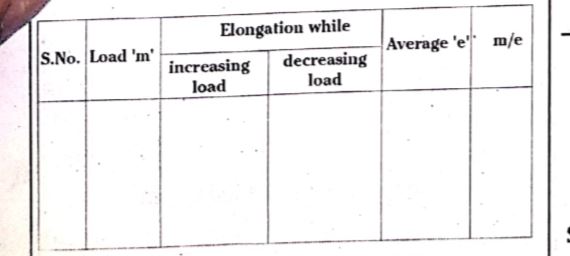InterviewSolution
Saved Bookmarks
| 1. |
Define Hooke's law of elasticity and describe an experiment to determine the Young's modulus of the material of wire. |
|
Answer» Solution :Hooke.s Law : Within elastic limit, stress is directly propportional to strain. `therefore"strain"prop"stress"` `("stress")/("strain")="CONSTANT"(E)` where E constant called modulus of elasticity of the material of a body. Determination of young.s modulus of a wire : The apparatus used to find young.s modulus of a wireconsists of two long wires A and B of same length made with same material are used. These two wires are sus- pended from a rigid support and a vernier scale .V. is attached to them. Wire A is con- nected to the main scale (M). A fixed load is connected to this cord to keep tension in the wire .This is called reference Wire. The second wire. .B. is connected to vernier scale .V.. Adjustable load hnger is connected to this wire. This is called experimental wire. Procedure : Let a load `M_(1)` is attached to the weight HANGER at vernier. Main scale reading (M.S. R) and vernier scale reading (V.S.R) are NOTED. Weights are gradually INCREASED in the steps of `(1)/(2)kg` upto a maxi- mum load of say 3 kg . Every time M.S.R and V.S.R are noted for every load, values are posted in tabular form. Let `1^(st)` reading with mass `M_(1)"is"e_(1)` and `2^(nd)"reading with mass"M_(2)"is"e_(2).` Change in load `M=M_(2)-M_(1)` `"elongation"e=e_(2)-e_(1)` .M. and .e. values are calculated and a garaph is plotted.  Average `m//e=` Force on the wire =mg Area of cross section of the wire `pir^(2)` `(r=radius of the wire)` Elongation = e Original length = l `"Stress=((F)/(a))=(mg)/(pir^(2))` `"Strain"=((e)/(l))` `"Young.s modulus,"Y=(("stress")/("strain"))` `thereforeY=((mg//l)/(epir^(2)))=((gl)/(pir^(2)))((m)/(e))`  A graph is between load (m) and elongation .e., is straight line passing through the origin. The SLOPE of the graph `(tantheta)` gives `((m)/(e))`. This value is substituted in the above eqution to find Young.s modulus of the material of the wire. Precations : 1. The load applied should be much smaller than elastic limit. 2. Reading is noted only after the air bubble is brought to centre of sporit level. |
|